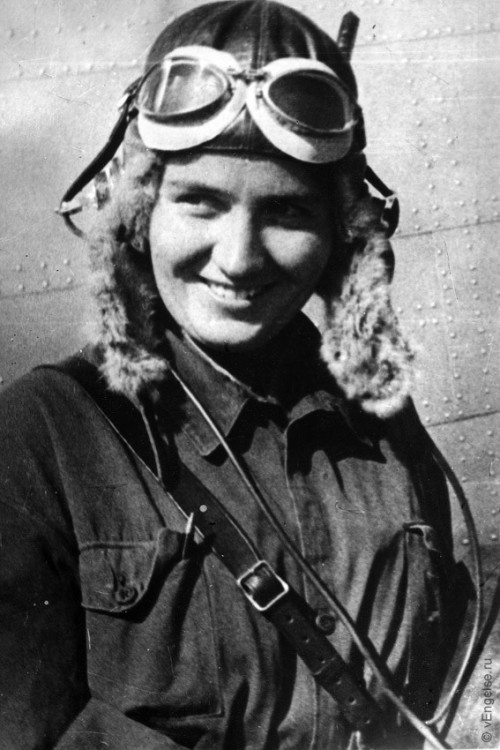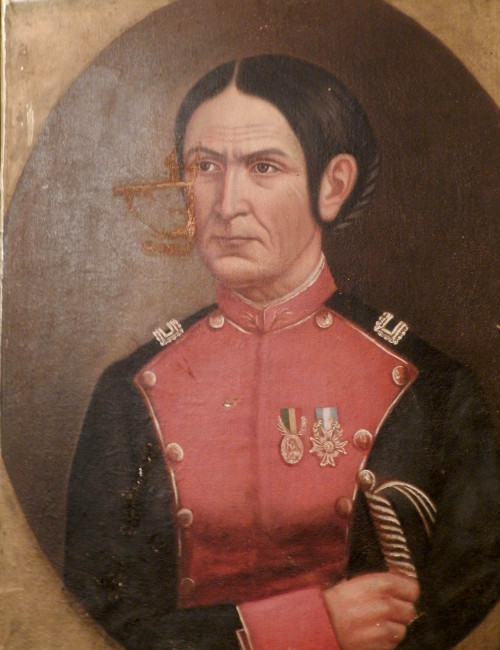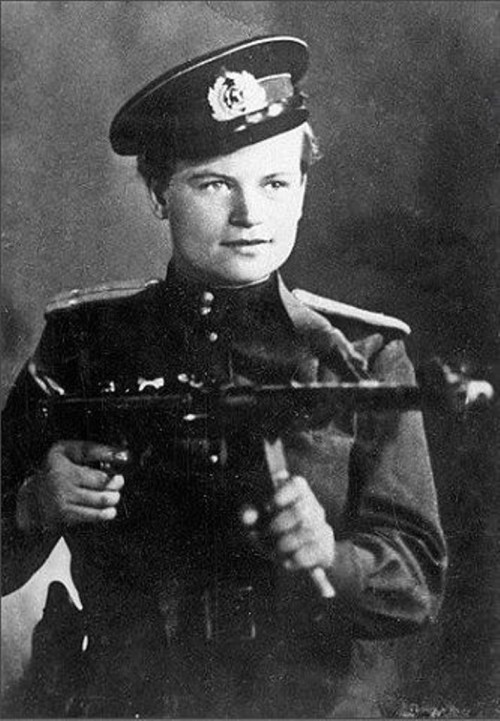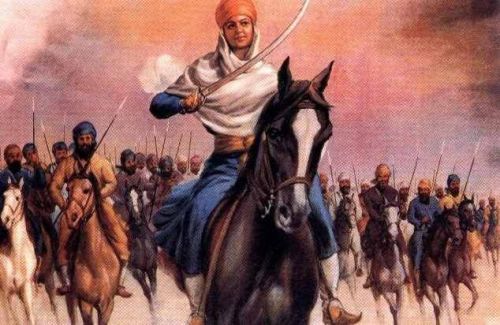#female commanders
Marina Raskova (1912-1943) was a Soviet pilot, navigator, and commander who founded 3 famous female air regiments during the Second World War.
Born to a middle-class Russian family, Raskova initially had aspirations of becoming a musician, but eventually abandoned the idea to study chemistry. While working in a dye factory as a chemist she met Sergei Raskov, an engineer, who she married and had a daughter with. She changed careers in 1931 when she joined the Aerodynamic Navigation Lab of the Soviet Air Force as a draftswoman. Aged 19 in 1933 she became the first female navigator in the Air Force and the following year became the first woman to teach at the Zhukovskii Air Academy.
In 1935 she divorced from her husband and focused on her flying career. She become a famous pilot as well as a navigator, setting a number of long distance records. This included the famous ‘Flight of the Rodina’ covering 6000km from MoscowtoKomsomolsk, which she conducted with two other female pilots, Polina OsipenkoandValentina Grizodubova. However the flight ran into difficulties at the end of its 26 and a half hour journey when poor visibility hampered the landing. As the navigator’s pit was vulnerable in crash landings, Raskova bailed out with a parachute while the two pilots completed the landing. She survived with no water and almost no food for 10 days before she found her way to landing site and reunited with her team. All 3 women were decorated with the ‘Hero of the Soviet Union’ award, the first women ever to receive it.
With the outbreak of World War 2 the Soviet Union was in need of pilots and many women volunteered. However while there were no formal restrictions on Soviet women in the military, many found their applications were denied or mysteriously delayed. Raskova proposed the creation of women’s aviation units and used her celebrity status to propose the idea directly to the Soviet leader Joseph Stalin. Following a speech by Raskova in September 1941 calling for women pilots to be welcomed into the war, Stalin ordered the creation of 3 new air regiments, the 586th Fighter Aviation Regiment, the 125th Guards Bomber Aviation Regiment, and the 46th Taman Guards Night Bomber Aviation Regiment, dubbed The Night Witches. These regiments were entirely formed of women, from the pilots to the engineers to the support staff. Each regiment contained around 400 women, most of them in their early twenties, who completed 4 years’ worth of training in a matter of months.
Raskova personally took command of the 125th Bomber Regiment, for which she obtained the very best equipment available, including the state-of-the-art Petlyakov Pe-2 bombers, which caused some resentment from male units. The 125th regiment went on to fly 134 missions over the course of the war, dropping over 980 tons of bombs.
Raskova herself was killed on January 4th 1943, while attempting to lead two other Pe-2’s to a safe airfield. She was forced into making a forced landing on the Volga Bank, which resulted in the deaths of the entire bomber crew. Raskova received the first state funeral of the war and her ashes were buried in the Kremlin Wall beside those of fellow pilot, Polina Osipenko. She was posthumously awarded the Order of Patriotic War 1st Class and the regiments she created continued to serve for the duration of the war.
Post link
Laskarina Bouboulina (1771-1825) was a Greek revolutionary and naval commander.
AnArvanite Greek born in a Constantinople prison, Bouboulina was the daughter of a ship captain from Hydra island. When she was a child her father died in the Orlov Revolution, a failed Greek rebellion against Ottoman rule. After this her extensive family moved to the island of Spetses. She married twice, first to a wealth shipowner and later to a Captain Bouboulis, whose name she took. When Bouboulis was killed by pirates, Bouboulina took over his trading business and began to amass her own fleet, commissioning the construction of four new ships.
In 1816 the Ottomans tried to seize Bouboulina’s property as her husband had fought with the Russians against them during the Turko-Russian wars. She managed to thwart these attempts with the help of Count Pavel Strogonov, the Russian Ambassador in Constantinople. However she was actively working against the Ottomans as a member of the Filiki Eteria, a secret organisation plotting to overthrow Ottoman control over Greece. Her principal role was as a smuggler, bringing food, weapons, and ammunition into Spetses. She also used her wealth to construct her own personal warship named the Agammennon, one of the largest vessels of the period.
In early 1821 the Filiki Eteria and other revolutionaries began the Greek War of Independence with support from Russia and other European powers. Twelve days before the war started Bouboulina was the first to raise the revolutionary flag, flying a modified Greek flag from the mast of the Agamemnon. She assisted the people of Spetses in their revolt before sailing with eight ships to Nafplion to begin a naval blockade. She later took part in the blockade and capture of the coastal cities of MonemvasiaandPylos. She was also present at the fall of Tripoli in September 1821, and during the subsequent attack on the Ottoman garrison she gave protection to the female members of the sultan’s household. In the aftermath of the battle she bore witness to the creation of the new Greek state, the First Hellenic Republic.
Over the course of the war Bouboulina was considered an equal with other revolutionary commanders and was involved in planning their strategy. She became good friends with General Theodoros Kolokotronis and their children later married. She settled in Nafplion, the new Greek capital, until 1824 when the Greek factions turned on each other in civil war. Kolokotronis was imprisoned by his former allies and Bouboulina was arrested twice due to her association with him. She was exiled to Spetses, her fortune having been exhausted from fighting for Greek independence.
In 1825 Bouboulina was killed in an argument with the head of the Koutsis family, whose daughter Bouboulina’s son had eloped with. While confronting the family from her balcony she was shot through the head and died instantly. After her death the Emperor of Russia gave her the honorary rank of Admiral in the Russian Navy, at the time the only woman in history to hold the title. Today she is remembered as a Greek national hero without whom the Greeks might never have gained their independence.
Post link
Juana Azurduy (1780-1862), also known as Juana Azurduy de Padilla, was a South American guerrilla leader who fought for independence from Spanish rule in the early 19th century.
Azurduy was born in Chuquisaca, in what is now Bolivia but was at the time part of the Viceroyalty of Río de la Plata, a Spanish territory which controlled present day Argentina, Bolivia, Paraguay and Uruguay. She was a mestiza by birth, born to a Spanish father and an indigenous mother, however following the death of her father she was raised to be a nun in a convent. She was expelled at the age of 17 for her rebellious behaviour.
Azurduy had a deep appreciation for the indigenous people of Bolivia and in addition to Spanish she spoke the South American languages QuechuaandAymara. In 1805 she married a man who shared this passion, Manuel Padilla, with whom she had four children. When the Bolivian War of Independence began in 1809 both Azurduy and Padilla immediately joined the revolutionary forces and went on to command a 2000-strong guerrilla army in the fight against the Spanish. Padilla was later made civil and military commander for a large area around Chuquisaca and by 1813 their army numbered nearly 10,000 soldiers.
Between 1811 and 1817, Azurduy fought in 23 battles in the effort to liberate the region. During this time Azurduy dressed in male cavalry uniform, keeping her hair under a military cap, and became proficient in fighting with swords, rifles and cannon. On March 8th 1816, her forces captured the Cerro Rico of Potosí, which was the main source of Spanish silver. During the battle Azurduy personally led a cavalry charge which captured the enemy standard. For these acts she was promoted to Lieutenant Colonel and was personally honoured by General Manuel Belgrano, who gifted her with his own sword.
However Azurduy’s successes came at great cost. Her children were captured by enemy forces and although she and Padilla launched a ferocious raid to save them, all of the children were killed. Azurduy herself was injured in the attempt and Padilla was captured and killed in late 1816. When the Spanish mounted heavy counter-attacks against Bolivian forces in 1818, Azurduy retreated with her forces into Northern Argentina. Here she continued to fight the Spanish with an army of 6000. She also gave birth to a new daughter in the middle of a battle, returning to the fight shortly after the child had been born.
In 1825 Bolivia declared independence and Azurduy was able to return to Chuquisaca. However her efforts in the wars were largely forgotten and she spent the rest of her life in poverty. She died in obscurity in 1862, however her memory has been resurrected in more recent times. She is now remembered as a national hero of both Bolivia and Argentina, has posthumously been granted the rank of General in the Argentinian army, and a 52-foot high statue of her was unveiled in Buenos Aires in July 2015.
Post link
LadyFu Hao was a queen, general and high priestess of the Shang dynasty in Eastern China during the 13th Century BCE.
Fu Hao first became known when she married the Shang king, Wu Ding, and became one of his 60 wives. Fu Hao took advantage of the semi-matriarchal slave society to ascend through the ranks of the royal household, gain a leading position in the Shang army and become Wu Ding’s most favoured wife.
As a warrior Fu Hao gained notoriety for her efforts against the Tu-Fang, who despite having been fierce rivals of the Shang for generations were completely defeated by Fu Hao in a single decisive battle. She went on to become the Shang’s most powerful military leader commanding a force of 13,000 soldiers with several other generals in service to her. She led successive military campaigns against the neighboring kingdoms of the Yi,QiangandBa. The last of these involved her leading the earliest recorded ambush in Chinese history.
Like other war chiefs Fu Hao was granted a fiefdom of land from the territories she conquered, from which she derived her own income. She was also an active politician and spiritual leader, acting as an adviser to the king and performing religious rituals as a high priestess. These were unusual roles for a woman at the time and reflected the faith that Wu Ding placed in her.
Following Fu Hao’s death the Shang’s military dominance weakened under attacks by the Gong, causing Wu Ding to make repeated sacrifices and prayers to Fu Hao’s spirit to defend them against invasion. Over the centuries Fu Hao’s accomplishments descended into myth and many historians did not believe that she had really existed until her tomb was uncovered at Yinxu in 1976. The tomb contained detailed records of her life on oracle bone, as well as an arsenal of weapons including battle-axes bearing her personal inscription.
Post link
Yevdokiya Zavaliy was a Soviet nurse, soldier and marine commander who fought in World War 2.
Born in 1924, Zavaliy was raised in a small village in the Mykolaiv region of Ukraine, where she worked on a farm. She was brutally exposed to the outbreak of World War 2 when enemy planes bombed her village and in the aftermath she treated injured soldiers by ripping up bed sheets from her home to make improvised bandages. The event left such an impression on her that she persuaded the commander of a cavalry regiment to take her with them to the front line, claiming to be 18 years old when she was in fact 16.
Zavaliy started serving with the regiment as a nurse, but during this time she learned to shoot rifles, pistols and machine guns. She also became directly involved in conflicts, taking a wound to the abdomen during the retreat at Khortytsia island and saved the life of a wounded officer by dragging him to safety. She was awarded the Order of the Red Star for her bravery, but this was only to be the first decoration she would receive.
One day an officer mistook Zavaliy for a man as she wore soldier’s clothes and her head had been shaved to remove lice. The officer ordered her to join a group of soldiers headed to the front line. Zavaliy decided to go along with the mistake and two hours later she took part in a battle near Goryachy Kluch with the 6th Airborne Brigade. She continued to serve in numerous battles under her new male identity and following her capturing of a German officer in combat she was appointed to commander of a reconnaissance squad. When Soviet troops were starving near Mozdok in late 1942, Zavaliy mounted a daring night raid across a river to a German camp, where she stole ammunition and provisions before sailing away on a raft.
The following year Zavaliy was a sergeant serving in the Kuban region when her company was surrounded during a heavy firefight and the company commander was killed. Seeing her fellow soldiers faltering Zavaliy took command, shouting for the men to follow her and leading them in a furious counter-attack which broke the enemy and sent them into retreat. The battle left her seriously injured and during her treatment the doctors discovered that she was a woman. Zavaliy expected to be dismissed and return to nursing, however in light of her many achievements she was allowed to stay in the army and in October 1943 she was promoted to commander of a submachine gunner platoon.
While the men of her platoon were initially reluctant to follow the orders of a teenage girl, Zavaliy quickly won their respect. The platoon was repeatedly deployed to the forefront of the most intense fighting, where Zavaliy led her men in daring attacks on German lines, taking part in the defense of the Caucasus, the battle for Crimea and ultimately the Soviet expansion across Eastern Europe. She became so feared by German soldiers that they nicknamed her ‘Frau Black Death’. Twice she was believed to have been killed in action but both times she returned unscathed. In her military career she was wounded a total of 4 times and received approximately 40 medals of honour.
Zavaliy was eventually discharged from the army in 1947 and traveled to Kiev where she married and had 2 children. She spent much of her life working as the manager of a grocery store but also toured many Soviet cities and army bases where she was celebrated as a military hero. She died in Kiev in 2010.
Post link
Pingyang (598-623) was a rebel general and later princess who helped found the Tang Dynasty in China.
During the early 7th Century, China was ruled by Emperor Yang of the Sui Dynasty, who was extremely unpopular thanks to starting numerous wars and ordering construction projects to expand the Great WallandGrand Canal which worked 6 million people to death. Pingyang’s father, Li Yuan, was one of Yang’s most successful generals. However in 617 the Emperor became paranoid about Li Yuan’s popularity and ordered for him to be executed. In response Li Yuan rose up in open rebellion against Yang’s rule.
At this time Pingyang was living in the capital, Chang’an, where her husband Cai Shao was head of the palace guard. With the news of Li Yuan’s rebellion the pair were forced to flee the city, separating to improve their chance of escape. Pingyang returned to her family estate to find the region was suffering from severe drought. She opened up the estate’s food stores to feed the local people and in doing so was able to recruit many of them to form her own army to fight against the Emperor, dubbed ‘The Army of the Lady’.
Selling everything her family owned to fund her rebellion, Pingyang added to her forces by assimilating the armies of local warlords, either through bribery or by defeating them on the battlefield and recruiting the surviving soldiers. She ultimately became commander of a force of over 70,000 rebels. She forbade her troops from looting, pillaging, or raping, instead insisting that after conquering an area that food should be distributed to the locals. Unsurprisingly this gained her immense popular support, increased even further by her repeated victories against the Emperor’s armies.
Joining up with the armies of her father and her husband, Pingyang’s forces captured the capital within a year. Yang fled the city and was later killed by his own men. Li Yuan became Emperor Gaozu of the newly founded Tang Dynasty, while Pingyang officially became a princess in addition to being awarded the rank of Marshall and the honorific title zhou, meaning ‘wise’. However she only lived a few years in this role, dying aged only 23 of unknown causes. On her death, her father broke with tradition and insisted that Pingyang was given a military funeral in honour of her achievements.
Mai Bhago, also known as Mata Bhag Kaur, was a Sikh woman who fought against the Mughal Empire in the early 18th century.
Mai Bhago was born in the village of Jhabal Kalan in the Punjab region of northern India, were in addition to being taught Sikh traditions she was trained by her father in horse riding and martial arts. She was a young woman during the period when oppression of Sikhs by the Mughal Empire was at its height. During 1704-05, the expansionist Mughal Emperor, Aurangzeb, invaded Sikh territory with an army of 16,000 troops and laid siege to the Sikh capital of Anandpur Sahib.
During the siege the Sikh leader, Guru Gobind Singh Ji, was abandoned by 40 of his elite warriors. Many of these men came from the region that Mai Bhago lived in and according to some accounts one of the deserters was her own husband. Outraged by this betrayal, Mai Bhago took her own horse, armour, and weapons and left home to track down the deserters. She went to their homes and persuaded their wives not to give their husbands shelter. Some of the women even armed themselves and joined Mai Bhago, pledging to fight for the Guru if their husbands would not. Shamed by this, the 40 deserters agreed to return to service with Mai Bhago.
During this time the Guru had escaped from the siege of Anandpur and was in retreat with his army. On 29th December 1705, Mai Bhago’s small force helped to cover the Guru’s retreat at the Battle of Muktsar. Knowing that the pursuing Mughals would need water she set up camp at the Khidrana reservoir, erecting numerous empty tents and clothes lines to make it appear as if a larger army was encamped there. When the Mughal army attacked the empty tents Mai Bhago’s force ambushed them and in spite of being heavily outnumbered managed to push the Mughals back after intense fighting. Although victorious, Mai Bhago was the only Sikh survivor of the battle.
After the battle Mai Bhago joined up with the Guru’s army and became his bodyguard. After the Guru’s death in 1708 she retired to Jinvara, where she lived to an old age. Today she is remembered as a Sikh heroine whose actions served to ensure the survival of her faith.
Post link






